Saltwater Crocodile Profile
Some animals have remained relatively unchanged for millions of years, sitting patiently in swamps and rivers, able to hold their breath for hours and lying almost dormant until a meal arrives.
The largest extant reptile has managed all of this, and not content with sticking to easily-avoidable stagnant pools, it’s added ocean navigation to its survival skillset.
The saltwater crocodile inhabits both saltwater wetlands and freshwater rivers and mangrove swamps across India, southeast Asia, and northern and western Australia.
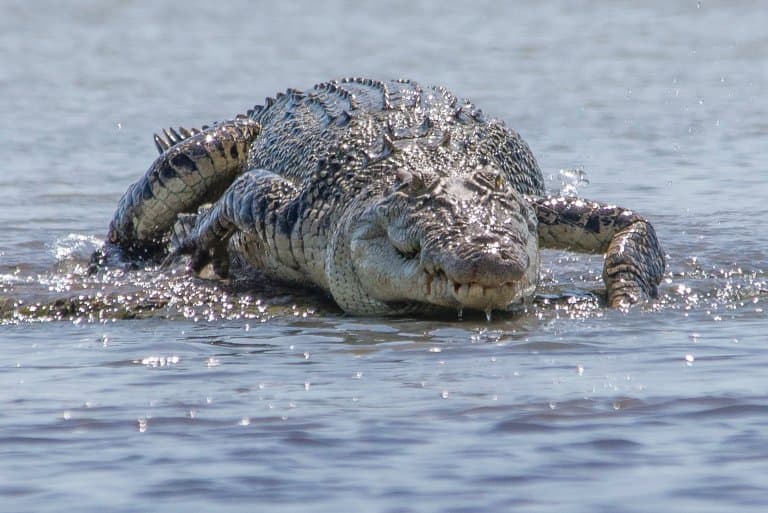
Saltwater Crocodile Facts Overview
| Habitat: | Fresh, brackish and salt water, coastal swamps |
| Location: | Australia, Southern Asia |
| Lifespan: | Upwards of 70 years |
| Size: | Over 6 m |
| Weight: | Over 1,000 kg (2,200 lb) |
| Color: | Green/brown |
| Diet: | Virtually any animal |
| Predators: | None |
| Top Speed: | 20 kph (12 mph) in short bursts |
| No. of Species: |
1 |
| Conservation Status: |
Least concern |
Saltwater crocs are a testament to “if it ain’t broke, don’t fix it”, having remained relatively unchanged for about 200 million years. They found a strategy that worked and they stuck with it, and they’ve reached record-breaking levels of reptilian excellence since.
There are 14 species of crocodiles which vary in lifespan between 35 – 75 years, and considerably in size. The largest species is the saltwater crocodile, which is often referred to informally as ‘saltie’, as well as the Indo-Pacific crocodile, or sea crocodile for obvious reasons.
While generally lethargic in nature, they are territorial and males will fight for dominancy of the best stretches of creeks, rivers and streams to occupy.
Saltwater crocodiles are opportunistic apex predators that ambush prey by drowning them, or swallowing them whole. They will eat virtually any prey, including mammals of various sizes, amphibians, reptiles, birds, fish and even other crocodiles, and sharks.
Despite being mostly sedentary, they’re capable of long-distance voyages, eating almost anything they can catch along the way, and settling to breed and chew on fishing boats.
While historically they have been hunted for their skin, meat and eggs almost to exctinction, today the saltwater crocodile is considered of least concern by the IUCN. They are protected from the effects of international trade under the Convention on International Trade in Endangered Species.
Interesting Saltwater Crocodile Facts
1. True to their name, they inhabit saltwater
One of the major differences between the saltwater crocodile and other species of crocodile is its behaviour of occupying saltwater habitats.
All crocodiles have salt glands that enable them to survive in saltwater, however most other species don’t venture out to sea. Alligators don’t have salt glands, and can’t survive at sea in the same way.
Saltwater crocodiles happily venture our into the ocean and use the currents to travel long distances.

2. They’re bird-like
Despite looking like big lizards, crocodiles are from a very different lineage. It might be easier to imagine a crocodile as a relative of the dinosaurs, though they predate those, too.
But, that’s not far off. When people say the dinosaurs died out, what they mean is that almost all of them died out. A handful remained, and repopulated to form the 10,000 species of birds we have today, and these birds’ closest living relatives are the crocodilians, who separated from their lineage around 240 million years ago.
One branch went on to become dinosaurs (and subsequently modern birds), the other stayed more or less the same and sat in swamps through two mass extinction events.
Crocodilians are a branch of archosaur, as birds are. And as such, branched off from the bird lineage far more recently than lizards and snakes. 1
3. They’re the largest species of croc, and reptile!
Salties are generally more rotund than their streamlined relatives, and have body shapes more like the North American alligators. They’re also incredibly long.
The longest reliable measurement of a saltwater croc was 6.2m drowned in a fishing net in Papua New Guinea, in 1979, and an individual this length will weigh twice the amount of a 5-meter giant.
A 6m saltie is more than capable of topping 1,000 kg, and though males of over 5m are hard to come by, they would have been a lot more common before people started shooting them for their skins.
Some researchers have tried to identify the head-to-body ratio of saltwater crocs, in order to be able to estimate their length from a skull sample or by measuring the head of the animal.
They came up with a ratio of 1:7, meaning that the total length is 7 times that of the head, but on closer inspection, it seems like these animals don’t grow in a linear fashion, making the ratio impossible to rely on.
Unconfirmed reports of 7m crocodiles are common, including one said to have eaten 13 women – inferred by the bangles retrieved from its stomach. 2
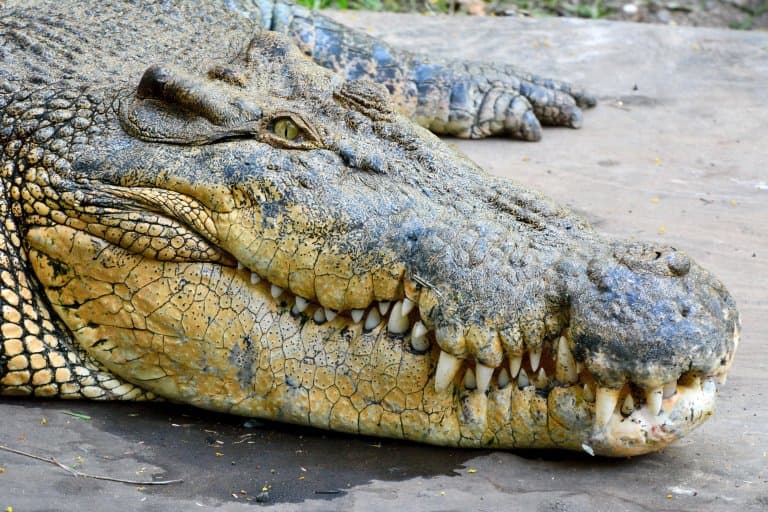
4. They can travel huge distances using ocean currents
Crocs don’t like to use a lot of energy. They don’t even breathe very often. So when salties discovered ocean currents they must have been really pleased with themselves.
These crocodiles are very happy in the ocean and use the natural currents to expand their ranges. They’ve been found well out to sea, sometimes even with barnacles attached to them. This adds an unexpected item to the long list of animals to avoid off the coast of Australia.
Satellite tagged crocs have even been recorded traveling 590km (370 miles) in the open ocean over a 25 day period.
Commonly, young males are forced out of their freshwater nurseries as they get older by more dominant crocs. They take to the high seas, riding on currents until they can find a comfortable territory. 3
4. They have antifungal properties
Despite their ocean chops, they still spend long periods in swampy, stagnant waters; areas riddled with fungal pathogens, and they do so without getting sick.
Because of this, their apparent immunity has become an area of curiosity in molecular biology, and recent research into the saltwater croc’s defences has brought up some very promising results.
The proteins found in the immune system of the crocodile closely resemble those found in humans, suggesting that there may be applications for developing treatments against infections in humans using crocodile proteins as a template. 4

5. They nest on land
While they spend most of their lives in water, their nests are built on the banks. In these nests, females can lay up to 90 eggs, which they’ll guard against predators, even carrying the hatchlings to water in their mouths after emerging.
Nests that get flooded will usually lose their eggs to drowning, but females have been seen slashing water around nests that are becoming too dry. This level of parental care is common in crocodilians, despite their reputation.
Those who survive the dangers of the wetlands will grow upwards of 70 years old and become the largest reptile on earth.
6. They’ll eat anything
When they’re young, crocs will stick to insects, frogs and small fish. Once they’re large enough, they’ll move onto mammals and birds, even other crocodiles.
While a full-grown saltwater crocodile can eat very large prey, smaller, more accessible animals make up a lot of their diet.
Saltwater crocodiles have immunity to toad poison which allows them to eat things that other crocs can’t.
Feral livestock makes up a large portion of their diet in some locations, and they’ll even hunt at sea, taking on snakes, turtles, and even dugongs.
A crocs stomach is the most acidic of all vertebrates, which allows it to digest its prey, including bones, hooves, horns and more.
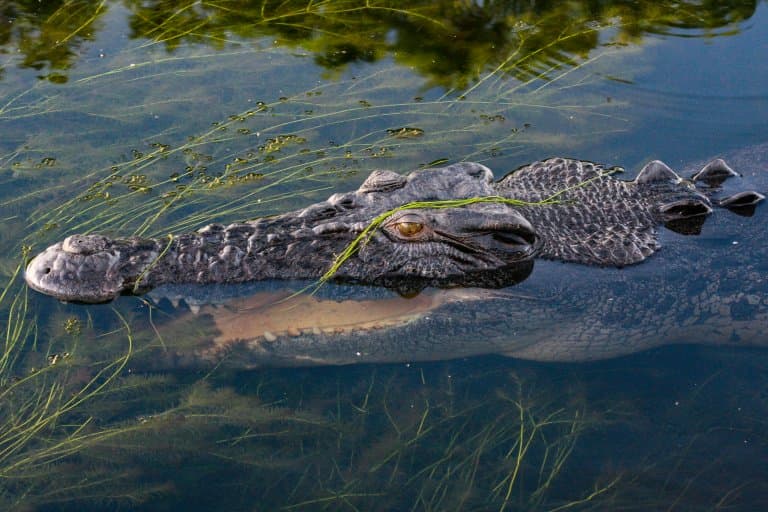
7. Sweetheart
Sometimes, they’ll even have a go at boats. While attacks on humans are very rare, there have been some high-profile cases.
One of which was a large male in an Australian fishing site, who was well known for nibbling at outboard motors and tipping fishermen out of dinghies into the water.
This terrifying scenario was offset by the classic Aussie humour as the nickname Sweetheart came about.
Sadly, on attempting to relocate Sweetheart, the croc was tranquillized and ended up drowning while being moved.
The 50-year-old male crocodile is now preserved in the Museum and Art Gallery of the Northern Territory and remains a part of local history. 5
8. Salties will bark, hiss, growl and ‘chirp’
Estuarine Crocodiles will communicate with each other using vocalizations, as well as visual and chemical cues.
Adult crocs emit low-pitched rumbling growls to predators or rivals during breeding season. They often include a snarl with a hiss at the end. Baby ‘hatchlings’ will chirp to their mothers.
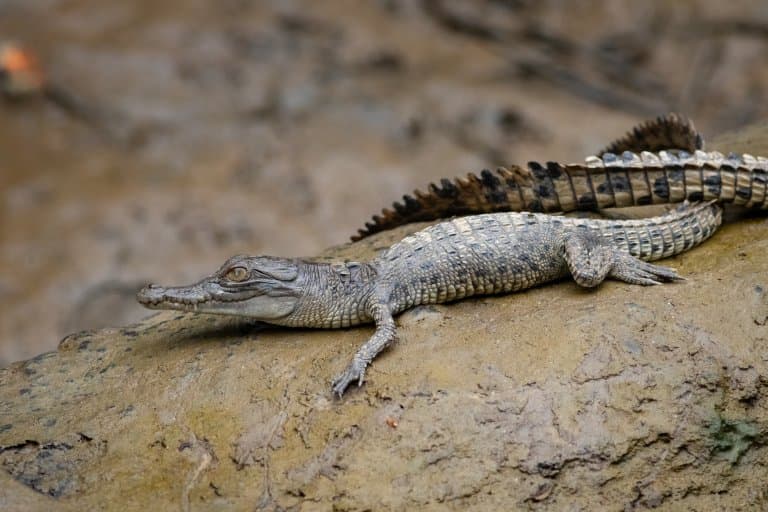
9. They can swim up to 29 kph
While often lethargic the saltwater crocodile is capable of swimming up to speeds of around 29 kph (18 mph) in the water in short bursts.
The fastest human swimmer on record has reached around 7.6 kph (4.7 mph) in comparison, so a croc is over 3 times faster!
Sometimes it’s cited that they can move equally as fast on land. While they can move quickly in sudden bursts, generally it’s a myth that they are capable of running fast on land.
10. They have the strongest bite force of any animal
Saltwater crocs have huge jaw muscles that are built for clamping down and are almost as hard to touch as bone.
A saltwater crocodile was recorded as having the strongest bite force ever recorded of 16,414 newtons (3,690 pounds-force), which surpassed the previous record of 13,172 N or 2,961 lbf from an American alligator.
While they have the strongest bite, and 66 sharp peg-like teeth on average, they are not particularly well suited to shearing flesh. Therefore ‘death rolling’ is performed on larger prey to tear them into more manageable bite-sized pieces.
Despite the huge jaw muscles for clamping down, they have very little muscle for opening their jaws, which can be held shut with just some duct tap! 6
11. They sweat through their mouths
Crocodiles cannot produce their own heat, or body sweat to help cool off. This means their body temperature is derived by the external environment around them.
So to cool off these crocodiles will sit along the river bank with their mouths open, which allows them to cool down in a similar way to a dog panting.
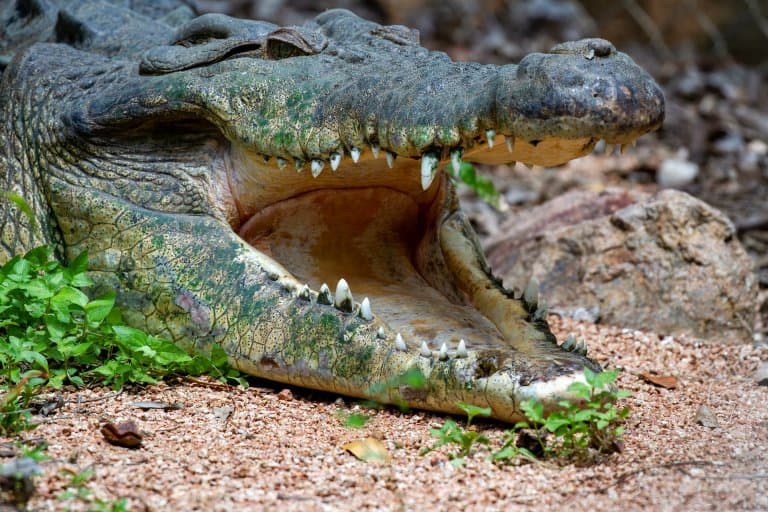
12. They are responsible for an estimated 20-30 deaths each year
Saltwater crocodiles are aggressive when they are encroached upon and have the strongest tendencies to treat humans as prey.
Estimates of fatalaties outside of Australia are difficult to come by, however it’s believed that they might be responsible for 20-30 deaths each year. In Australia they account for one, or two fatal attacks every year.
Extensive efforts have been made to in Australia to make the public aware of risks of crocodiles with appropriate warning signs in rivers, lakes or beachers with crocs.
In general the best approach is to stay clear from any habitat that may have saltwater crocodiles, as the chances of survival if they attack are very low.
13. Over 400 Japanese soldiers were eaten by crocodiles in 1945
During the Japanese retreat in the Battle of Ramree Island in World War 2 in 1945, saltwater crocodiles are believed to be responsible for the deaths of over 400 Japanese soldiers.
Soldiers fighting in the area had been eating small mammals during their occupation which had led to scarcity of food for crocodiles.
As the British forced the Japanese soldiers to retreat for a night in the mangrove swamps, they were set upon by now very hungry saltwater crocodiles which resided there in the thousands.
Saltwater Crocodile Fact-File Summary
Scientific Classification
| Kingdom: | Animalia |
| Phylum: | Chordata |
| Class: | Reptilia |
| Order: | Crocodilia |
| Family: | Crocodylidae |
| Genus: | Crocodylus |
| Species Name: |
Crocodylus Porosus |
Fact Sources & References
- Tim Stephens (2014), “Scientists reconstruct genome of common ancestor of crocodiles, birds, dinosaurs“, UC Santa Cruz.
- Rom Whitaker and Nik Whitaker (2008), “WHO’S GOT THE BIGGEST?“, Crocodile Specialist Group.
- “Crocodylus porosus“, Crocodilian Species List.
- Williams, S.A., Lay, F.T., Bindra, G.K. et al (2023), “Crocodile defensin (CpoBD13) antifungal activity via pH-dependent phospholipid targeting and membrane disruption“, Nature.com.
- “Sweetheart“, MAGNT.
- Gregory M. Erickson et al (2012), “Insights into the Ecology and Evolutionary Success of Crocodilians Revealed through Bite-Force and Tooth-Pressure Experimentation“, Plos One.
